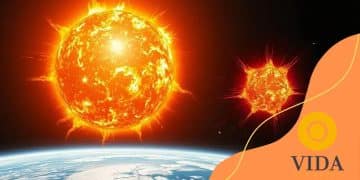Space debris crisis sparks international regulatory talks

The space debris crisis sparks international regulatory talks, highlighting the urgent need for effective management technologies and collaborative efforts to mitigate the risks posed by debris to active satellites and future space missions.
Space debris crisis sparks international regulatory talks as nations realize the growing threat to our satellite infrastructure.
With thousands of pieces orbiting Earth, what does this mean for the future of space exploration?
Understanding the space debris crisis
Understanding the space debris crisis is crucial in today’s era of space exploration. As more satellites are launched, the amount of debris in orbit has significantly increased.
This debris poses risks not only to operational satellites but also to future missions and space stations.
The danger of this crisis affects everyone. For instance, a collision between operational satellites can render both inoperable.
Additionally, even small pieces of debris can cause substantial damage due to their high velocities.
What is space debris?
Space debris, also known as space junk, consists of non-functional satellites, spent rocket stages, and various fragments from collisions or explosions.
These materials orbit the Earth and are often moving at speeds of over 17,500 miles per hour.
Causes of the space debris crisis
- Increased satellite launches for communication and observation.
- Expired satellites remaining in orbit.
- Collisions between satellites and other debris.
The situation has reached a point where proactive measures are necessary. Several countries and organizations are beginning to take action, yet more collaboration is needed to achieve comprehensive solutions.
Understanding the implications of the space debris crisis is vital for ensuring the safety of future space endeavors.
As we continue to explore space, we must prioritize effective management of what is already there to prevent disastrous consequences.
Impacts of space debris on satellite operations

The impacts of space debris on satellite operations are significant and growing. As the number of active satellites increases, the risk of collisions with space debris also rises.
Even small fragments can pose a major threat due to their high speeds.
When collisions occur, they can lead to complete satellite failure or damage that affects the satellite’s performance.
This is not just a technical issue; it can disrupt communications and affect services that rely on satellites.
Types of impacts on satellites
One key impact of space debris is the possibility of catastrophic damage. A collision can create more debris, which leads to a larger risk for all satellites in orbit.
Operational challenges
- Increased costs for tracking and avoiding debris.
- Need for more robust satellite designs to withstand potential impacts.
- Delays in satellite launch schedules due to collision avoidance maneuvers.
Additionally, satellites may need to perform maneuvers to avoid debris. These maneuvers increase fuel consumption and reduce the satellite’s operational lifespan.
This situation makes mission planning more complex.
The effects extend beyond individual satellites; they can also impact entire constellations. A loss of one satellite can diminish the functionality of related systems and services.
As the space debris crisis worsens, the importance of understanding its impacts on satellite operations becomes even clearer.
Stakeholders in the space industry must take action to address these challenges.
Current international regulations addressing space debris
Current international regulations addressing space debris are vital for the future of orbital safety. As awareness of the issue grows, so does the need for effective policies that govern the use of space.
Several key frameworks and agreements focus on minimizing space debris and promoting responsible practices. These regulations aim to ensure that all space-faring nations share the responsibility of keeping our orbits safe.
Key international frameworks
- The United Nations Office for Outer Space Affairs (UNOOSA) provides guidelines for space debris mitigation.
- The Inter-Agency Space Debris Coordination Committee (IADC) develops recommendations for space debris prevention.
- The Outer Space Treaty emphasizes the importance of avoiding harmful contamination.
With the increase in satellite launches, countries are urged to adopt these guidelines. Failure to comply could lead to serious consequences not only for individual nations but also for global space operations.
Challenges in regulation enforcement
Despite existing regulations, enforcement remains a challenge. Many countries may lack the resources to monitor compliance effectively.
Moreover, the growing number of private companies entering the space sector complicates the regulatory landscape.
As we look to the future, stronger collaboration and binding agreements may be necessary.
Countries must work together to establish clear rules and responsibilities to tackle the space debris crisis more effectively. This collaborative approach is essential to protect the shared resource of outer space.
The role of technology in tracking debris

The role of technology in tracking debris in space is becoming increasingly important. As the number of satellites grows, so does the risk posed by space debris.
Technology helps monitor these objects and predict potential collisions.
Advanced tracking systems use radar and optical sensors to detect debris. These systems provide data on the size, speed, and trajectory of each piece of debris, allowing operators to make informed decisions.
Types of tracking technologies
- Radar systems: Ground-based radars can track large pieces of debris and provide real-time data.
- Optical sensors: Telescopes can spot smaller debris that radar may miss, improving overall tracking capabilities.
- Data analytics: Algorithms analyze the tracking data to predict potential collisions and assess risks.
As technology advances, new methods are also emerging. For instance, some organizations are testing artificial intelligence to improve tracking accuracy and efficiency.
AI can process massive quantities of data faster than human analysts, making space monitoring more effective.
Additionally, international collaboration is crucial for sharing tracking data. By working together, countries can enhance their ability to monitor space debris and protect their satellites and other space assets.
Technology not only tracks debris but also plays a critical role in ensuring the safety of future space missions.
Future prospects for space debris management
Future prospects for space debris management hold exciting possibilities. As awareness of the issue grows, so do the technologies aimed at tackling the crisis.
New strategies are emerging to mitigate the risks posed by debris in orbit.
One of the most promising approaches is the development of removal technologies.
These systems can capture and deorbit debris, thereby reducing its impact on operational satellites.
Innovative removal technologies
- Robotic arms: These can grab debris and pull it down into the Earth’s atmosphere for burning.
- Harpoons: These devices can latch onto large pieces of space debris for safe removal.
- Net systems: Nets can ensnare smaller debris and safely guide it back to Earth.
Another area of focus is improving regulations and international cooperation. As more nations and companies launch satellites, a coordinated effort is essential for managing the growing debris population.
In addition, adopting best practices during satellite design and end-of-life disposal is crucial.
By ensuring that satellites are deorbited safely at the end of their operational life, we can minimize future debris generation.
Advancements in tracking technology will also play a significant role. Enhanced monitoring systems will help predict collisions and facilitate timely maneuvers to avoid them.
As we look ahead, the key to successful space debris management lies in innovation and collaboration. With dedicated efforts from the global community, it is possible to create a safer orbital environment for future generations.
As the crisis of space debris grows, it is clear that immediate action is necessary. By understanding the impacts of space debris on satellite operations and the importance of international regulations, we can work toward effective management solutions.
Innovations in technology, like tracking and removal methods, will be crucial in safeguarding the future of space exploration.
It is essential that nations cooperate and prioritize safe practices to preserve our celestial environment and ensure the success of future missions.
Together, we can navigate the challenges of space debris and protect the wonders of outer space for generations to come.
FAQ – Frequently Asked Questions about Space Debris Management
What is space debris?
Space debris consists of defunct satellites, spent rocket stages, and fragments from collisions or explosions that orbit the Earth.
Why is space debris a concern?
Space debris poses a threat to active satellites and space missions due to the potential for collisions, which can cause significant damage.
What technologies are used to track space debris?
Technologies include radar systems, optical sensors, and data analytics, all designed to detect and monitor debris in orbit.
How can international cooperation help manage space debris?
International cooperation allows countries to share resources, data, and best practices to effectively manage and reduce space debris.






